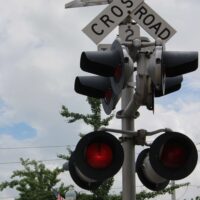Hazards Drivers Face at Railroad Crossings

Drivers may assume that if they come upon a railroad crossing and the lights are not blinking, there is no train coming. Think again. With 136,000 highway-rail crossing intersections in the U.S., it’s likely a driver will come upon one of these intersections and all drivers need to understand how to stay safe.
Some trains can take a mile or longer to stop, so it’s up to the driver to modify his behavior at a crossing. In the last decade, 3,600 people have died at more than 30,000 railroad crossings in the U.S., according to the nonprofit Operation Lifesaver.
In 2017, there were 2,105 collisions between vehicles and trains. Most of these railroad crossing accidents happened within 25 miles of one’s home. The Federal Highway Administration (FHA) reports Alabama suffered 68 collisions at railroad crossings in 2010, making it seventh in the nation for such accidents.
Alabama is, unfortunately, one of the ten most dangerous states for railroad crossing fatalities, according to the group. Half of those collisions occurred when there was an active warning such as lights, gates, and bells.
When a train hits a car, the results can be catastrophic, and many of these deaths could have been prevented.
Alabama Law at Railroad Crossings
When approaching a railroad crossing, it’s vital to understand the rules of the road. According to federal statistics, many of the fatalities at these crossings were due to drivers maneuvering around railroad crossing gates or failing to check for any oncoming trains.
- When approaching a railroad crossing, the law states that you must stop your vehicle within 15 to 50 feet of the crossing.
- When the gate is lowered, you must also stop, whether or not a train is approaching.
- Make sure all of the tracks are clear of approaching trains before crossing. Never assume there is just one train coming from one direction.
- The driver needs to slow down when crossing the track enough to make sure he can stop when first seeing a train.
- If your car stalls on the rail track, abandon the vehicle immediately, even if you do not see a train approaching. Call 9-1-1.
Hazards at Railroad Crossings
In the past, many railroad crossing crashes occurred at places where there was only an antiquated sign, such as a crossbuck or a stop sign. That has changed over the years, and now most of the more dangerous crossings have been equipped with active devices and electronic warnings.
Taking a look at why collisions still occur, we find:
- Inoperable Warnings – Such as bells, lights, or gates that are in disrepair
- No Maintenance at the Crossing – Watch for overgrown trees, broken limbs, or vegetation that obstructs the warning or the long view of an oncoming train
- Failure to Install – In some cases, proper warnings were never installed, such as functioning cross gates, lights, or crossing bells
- Improperly Parked Train – If a train is inoperable or parked at or near a crossing, it can prevent a motorist from seeing the conditions and give them a false sense of security
- Failure to sound the train’s horn or whistle at or near the crossing
- Driver error – some passengers engage in risky behavior at a railroad crossing, such as passing through a descending gate or driving around lowered gates
- Assumptions – Some trains are three feet wider than the tracks on both sides, requiring a pedestrian or vehicle to clear the area
Your Alabama Driver Safety Attorney
The good news is that the number of highway-rail crossing deaths and injuries has dropped over the past 50 years, but it is still a problem. Every three hours, a person or vehicle is hit by a train in the U.S., and in 2020 that led to 5,479 injuries at railroad crossings.
If you are injured at a rail crossing, you can be assured that the insurer for the other side will apply the Alabama “contributory negligence” doctrine to your case. That means if you share in any degree of fault for the accident, the insurance company will argue you should not recover the losses associated with an accident.
Chip Nix has spent the last 50 years helping individuals injured in personal injury accidents, including car and truck accidents, motorcycle accidents, slip and falls, workplace accidents, burns, bicycle, and boating accidents.
He will devote personal attention to your circumstance if you call today at 334-203-6669 to schedule a complimentary consultation.





